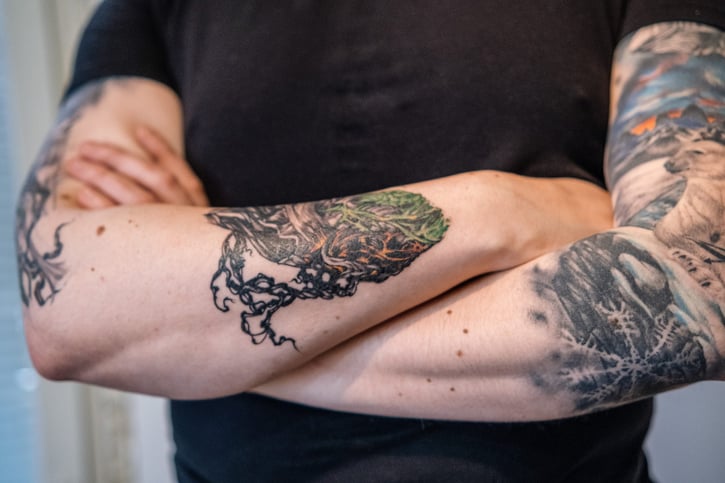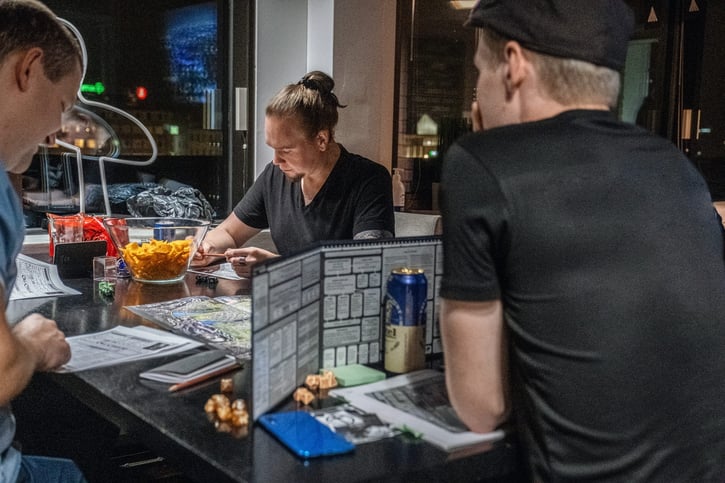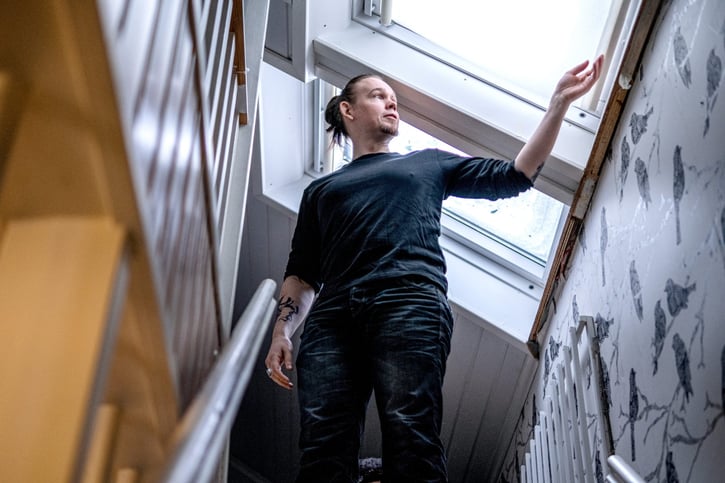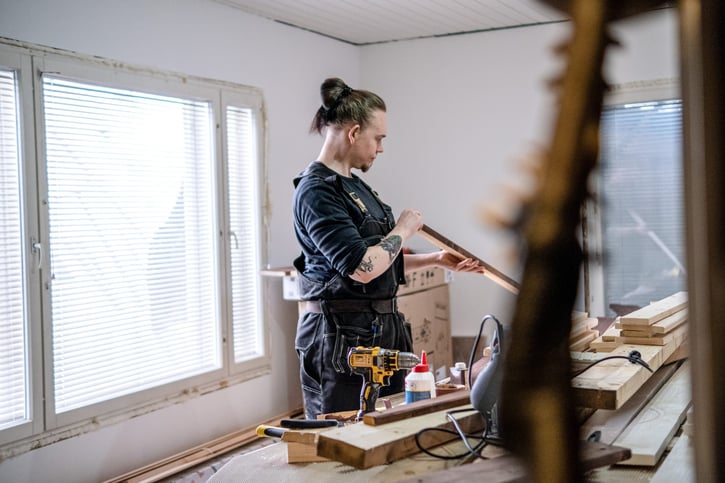Dreaming of an electric Harley Davidson and a modernised house from the 50s. Kimmo Kuusinen is not satisfied with ready-made solutions for pretty much anything. From digital services and computers to motorcycles and houses, he rebuilds things or even builds them from scratch.
A young man watches excitedly as a small pump circulates water through copper blocks into the cooler of a computer he has built himself. Hope nothing gets fried.
It’s the early 2000s and there is no mention of DIY videos yet. Teenager Kimmo Kuusinen has spent dozens of hours comparing prices and figuring out which part goes with which, and built himself a computer that can withstand hours-long gaming sessions.
And so the games go on this time too.
“I did manage to break a couple of pretty expensive graphics cards, but otherwise the damage was surprisingly minor,” Kuusinen reflects now, sitting at the office of his employer, Haallas* (now Siili Solutions), in the centre of Joensuu.
Specialising in problems
The 36-year-old Senior UX designer continues to be one of those men for whom ready-made solutions are not enough. You can always make the picture a little better, the machine a little more efficient and the whole thing more suited to your needs.
For his work, Kimmo designs the user experience of his clients’ digital service platforms. A user experience designer may spend a day with the end-users, such as home care nurses or miners, just to understand what they actually need a reporting tool for and what they need to be able to do with it.
Once Kimmo has a good enough understanding of the client’s needs, he starts designing how the tool should work to best serve the user. Problem solving is what drives Kimmo. It can sometimes require a long process, but each time the end result is rewarding.

“I love it when I can get a decisive clue from the client as to why something in the interface is not working. The insight comes when I combine the information from the client or feedback from the users with my own expertise.”
Kimmo had to beat his own career path
Kimmo actually also solved the problem of his own career path and practically created a job for himself.
When he started studying information technology, he had hardly heard of UX designers.
It was clear to Kimmo that he wanted to study IT, and he started his studies in the Degree Programme in Information Technology at the University of Eastern Finland with high expectations. However, the content of the studies immediately felt alien to him.
“I took some basic Java course several times because I couldn’t pass it. The studies were very programming-oriented, which didn’t feel like my thing.”
However, Kimmo himself could not quite articulate what he wanted from his studies, let alone what he wanted to be when he grew up. He only knew he wanted to work in technology.
“You could tell from my friends who were interested in coding that they had a passion for it that I lacked. But I knew it was the right field.”
Kimmo transferred from the university to Karelia University of Applied Sciences in the hope that he would there find the answer to his feeling of being an outsider. Even there, however, he was strongly steered towards programming. The addition was a business mindset.
Although the subjects he was studying still did not feel entirely his own, Kimmo was beginning to feel a spark of sorts.
“In group projects, I found that I liked to do the job of stylising the interface. For the first time, it felt like my thing, something I wanted to do more of.”
At that time, there was hardly any teaching on the subject in North Karelia. However, the programming Kimmo learned at school and in his spare time, with the help of his study mates, was considerably useful when applying for different jobs.
Just what is a UX designer?
Then Kimmo’s friend spotted an advertisement online for Sharepoint recruitment training. Kimmo decided to apply for the training, and once he got in, he packed his bags and returned to his hometown of Savonlinna. The training gave him his first job in an IT company and a new perspective on what the industry does.
“There I quickly realised that I really had little to offer in coding. But I also realised that designing the layouts is its own area, and that it could be my thing.”
The title UX designer started to appear more and more in Kimmo’s field of vision; at times, it came up in literature and other times in job advertisements. So he set out to find out what the pair of words was all about.
The more he read on the subject, the more confident he became that he had finally found a direction for his career. He wanted to design how different interfaces work, what they look like and what they can achieve at their best.
When Kimmo’s workplace was reorganised and the technical department was downsized, he started looking for a new job with the specific idea of becoming a designer of user experience, a UX designer.
No more impostor syndrome
After several job applications, interviews and deliberations about where to live, it finally happened: an IT company in Joensuu was looking for a UX designer. Kimmo applied for the job and got it. But his career as a designer did not immediately take off.
“I was the company’s first designer, and I was suffering from a terrible impostor syndrome. I knew a lot about the work on a theoretical level, but I hadn’t done a day of actual design work.”
Kimmo achieved many good things in the company, e.g. in the conceptualisation of services, but when it came to convincing the management of the need for his ideas, both his own and the company’s inexperience in design work was highlighted.
“I just simply couldn’t sell my ideas to the management.”
At the end of the one-year fixed-term contract, Kimmo’s contract was not renewed.
However, he was almost immediately offered a design position at another international IT company operating in Joensuu. Now Kimmo was able to do more interface coding, and design work on the side.

Now, four years later, Kimmo works as a senior-level designer at Siili Solutions. There, he gets to apply the insight he has gained over the years into user interface design in an increasingly diverse way.
“I no longer have impostor syndrome. Without any smugness, I can say that I know what I’m doing.”
At Siili, employees are also encouraged to learn new things and develop themselves.
“In this job, I have a passion to keep improving. Of course, I’m not perfect, and no one will ever be.”
More criticism, please
At Siili, Kimmo gets to work on diverse design projects as part of a larger team. There are usually a couple of projects going on at the same time, and Kimmo divides his time between them.
“Depending on where the project is at, I draw wireframe models or more advanced user interfaces, build prototypes or conduct user research.”
The design software Kimmo uses is Figma, which is used to produce all visible content. Communication is also a big part of the job, and several communication tools are used to communicate with both colleagues and clients.
Feedback from the client is invaluable. It has been mostly positive, which in Kimmo’s view is of course a good thing, but at the same time regrettable.
“You learn so much from constructive criticism that I would like to receive it more often.”
To learn more, Kimmo reads a lot of literature on the subject and keeps a close eye on developments in the field.
However, he feels that he learns most from discussions with his team.
“We are all professionals with our own strengths and interests. You always learn something new when you talk about them. Sometimes it’s the smallest thing that turns out to be a big help in practice.”
Kimmo also enjoys spending time with his colleagues in his free time. They have board game nights together where they talk about more than just work, although they do talk a little about that too.

“I’ve always liked different kinds of games. Fortunately, there are some very like-minded people at our workplace. We have a great team,” Kimmo says.
A nightmarish motorbike ride
Kimmo is also a developer by nature, not just by profession. Listening to his stories, you might even think that he creates problems for himself in order to solve them.
A year ago, while walking past a driving school, Kimmo got it into his head to buy a motorbike, even though he does not really admit to being a motorbike enthusiast. He found an interesting custom bike in Simo, on the other side of Finland, and took the morning train there, bringing his day’s work with him.
The bike turned out to be perfect, and Kimmo bought it right then and there. Having started his day’s work on the train, he finished it in a café in Simo, after which he took his new bike and headed for North Karelia. Although Kimmo had had his motorcycle licence for a few years, this was the first long ride he had ever taken. The total distance to cover was almost 600 kilometres, which is a long ride even for an experienced motorcyclist.
Kimmo was carrying two work laptops and a change of clothes, all stuffed in his backpack. He had to carry the heavy load on his back for the whole journey, as there were no bags on the bike in question. And the journey was not made any easier by the autumn storm that swept over the return route.
Driving through the thunder and heavy rain, Kimmo admits that his faith in the wisdom of the purchase decision faltered.
“At some point of the journey, I really thought I was going to die. I was so cold and tired. I asked myself if this was worth it.”
He survived, however, and both the bike and the man eventually made it home. At home, true to himself, Kimmo disassembled the bike, examined the parts and then reassembled, repaired, painted and customised it.
He even learned modelling and bought a 3D printer to make the fibreglass parts he wanted for the bike himself.
Kimmo is fascinated by the idea of making a hobby his own. He also has everything but the funding to transform a classic Harley Davidson into an electric one.
“I think it’s a fun idea to turn a monster like a Harley Davidson into a completely silent and more ecological vehicle,” he grins.
Never-ending construction project
Somewhat the same thing happened with Kimmo’s home. He had been looking for a detached house for some time. At first, he dreamt of a new house where he could choose all the materials himself, but it soon became clear that this would require too big an investment.
The ecological aspect was also a big part of the decision to buy an old house. Kimmo spent weeks researching in which decade people built the houses with the best durability if properly maintained. After mapping out common problems and the flaws typical to different kinds of houses, he finally settled on a 50s ‘rintamamiestalo,’ a type of house built for soldiers returning from the war.

“These types of houses are usually well built, although not very energy-efficient.”
But that did not bother Kimmo, as he had his own vision for the house anyway. At first it was a couple of small changes, but they eventually led to a slightly larger renovation.
“I completely dismantled half of the downstairs and ended up moving the kitchen to a different part of the house. I also knocked down one of the interior walls, completely dismantled the exterior walls and re-clad the house.”
Because Kimmo had no previous experience in renovation or building services, but plenty of vision, the project has grown into a massive undertaking with no end in sight. He has researched ventilation and insulation as well as breathable structures and different natural materials.

“I need to understand how this kind of a house works, so that I don’t ruin it, but rather make it better than it was,” he says.
Kimmo appreciates everything old and traditional, but on the other hand he needs some things, such as electronics and technology, to be modern, if only for the sake of energy efficiency. Granted, he admits that ecological aspects do not come first in everything.
“I still have a ways to go in learning that I don’t always need to have the latest IT equipment, for example, and that I can fix my existing equipment instead.”
The house project has also affected Kimmo’s hobbies. For example, his beloved music hobby has sometimes been on a break. Since his school days, Kimmo has been a vocalist in a metal band he founded with his friends.
“We’ve mostly been playing for fun, with some gigs here and there. Then, one by one, my bandmates began to start families. And I’ve had this house project. So the last few years have been quieter.”
Last spring, Kimmo was asked to record the vocals for a fledgling band’s album. He stayed on that path and is now the band’s regular lead singer.

The band’s goal is not to live out the rock and roll dream, but rather to play together and have fun.
“A fledgling band fits my life situation perfectly right now.”
Going upwind, you need to zigzag
Although Kimmo particularly enjoys user research in his work and thus working with people, it is sometimes mentally demanding.
For an introvert, social situations are stressful and require recovery. Therefore, in his free time, Kimmo likes to do things on his own.
Sailing has been a passion of his since he was little. He started sailing at the early age of 7 with his family. Nowadays, he likes to sail on his own.
“I’ve tried everything from football to hockey, and I was never any good at team sports. Sailing is the first thing I’ve genuinely been good at.”
The best thing in Kimmo’s opinion is to take a boat to the open waters of Lake Saimaa and camp on a suitable island.
Sailing is not simply about chilling out and admiring the scenery; it requires a lot of knowledge. To know how to sail, you need to understand the theory of the sport, and that fascinates Kimmo.
“You need to know how each boat behaves, how to position the sail and how to beat upwind. You need to zigzag.”
And of course you have to be able to read the signs. You need to be able to identify buoys, so that you avoid running aground and reach your destination.
“When there are enough challenges and the opportunity to develop, you stay interested,” Kimmo says.
Just like it always is in life.
*Siili Solutions acquired Haallas' business in October 2022. You can read more about it by following this link.
Teksti: Annika Lius
Kuvat: Tuomas Kinnunen

